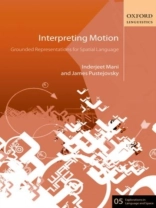Interpreting Motion presents an integrated perspective on how language structures constrain concepts of motion and how the world shapes the way motion is linguistically expressed. Natural language allows for efficient communication of elaborate descriptions of movement without requiring a precise specification of the motion. Interpreting Motion is the first book to analyze the semantics of motion expressions in terms of the formalisms of qualitative spatialreasoning. It shows how motion descriptions in language are mapped to trajectories of moving entities based on qualitative spatio-temporal relationships. The authors provide an extensive discussion of prior research on spatial prepositions and motion verbs, devoting chapters to the compositional semantics ofmotion sentences, the formal representations needed for computers to reason qualitatively about time, space, and motion, and the methodology for annotating corpora with linguistic information in order to train computer programs to reproduce the annotation. The applications they illustrate include route navigation, the mapping of travel narratives, question-answering, image and video tagging, and graphical rendering of scenes from textual descriptions. The book is written accessibly for a broad scientific audience of linguists, cognitive scientists, computer scientists, and those working in fields such as artificial intelligence and geographic information systems.
Inderjeet Mani & James Pustejovsky
Interpreting Motion [PDF ebook]
Grounded Representations for Spatial Language
Interpreting Motion [PDF ebook]
Grounded Representations for Spatial Language
Acquista questo ebook e ricevine 1 in più GRATIS!
Lingua Inglese ● Formato PDF ● ISBN 9780191632501 ● Casa editrice OUP Oxford ● Pubblicato 2012 ● Scaricabile 6 volte ● Moneta EUR ● ID 2276258 ● Protezione dalla copia Adobe DRM
Richiede un lettore di ebook compatibile con DRM












